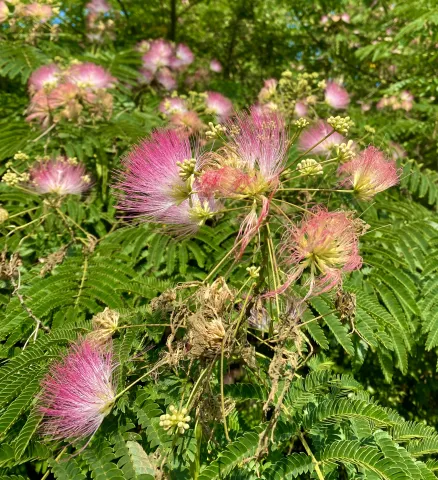Murmurings about Mimosa

Mimosa is easy to spot right now along roadsides. It's considered invasive and competes with native plants for sun and resources.
By: Steve Roark
Volunteer, Cumberland Gap National Historical Park
Mimosa (Albizia julibrissin) is an imported landscape tree that is very common in our area and is most noticed when it produces its fluffy pink flowers in the summer. Its commonness has been a concern from a forest health standpoint.
Mimosa is native in places like Iran and Japan and was brought to North America as a yard ornamental. It then naturalized into the wild and can be seen growing along roadsides and in abandoned fields, especially right now when it is full bloom. It is a smallish tree growing to only about 40 feet tall but has a wide spreading crown. It has feather-like compound leaves that are 9-12 inches long and made up of many small finger-like leaflets. The flowers are fragrant and look like bright pink powder puffs. The fruit is a long bean pod that turns brown and hangs on the tree into winter. Teas and tinctures made from the bark and flowers have traditionally been used as an herbal medicine to improve mood and relieve anxiety.
What worries me about mimosa is its encroachment, for I’m seeing more of it around. It’s listed as an exotic invasive plant, meaning it has potential to shove aside our native trees that are much more important for timber and wildlife, and messes with the forest ecosystems. If you have mimosa on your property and are not using it as a landscape plant, I recommend eradication to prevent its spread.
The list of invasive exotic plants is getting longer each year: kudzu, multiflora rose, buttercup, autumn olive, tree of heaven, and a multitude of other plants are taking over in places and their control gets more expensive each year. Beware of what you plant on your land. Do some research to make sure you’re not turning loose a green Frankenstein.
- Log in to post comments